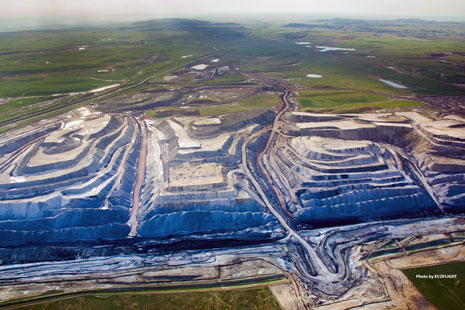For every step forward in 2017, the coal industry saw at least two steps backward. The slow unraveling of the industry will take time, but each passing month begs certain questions about the future more and more urgently.
Will coal communities and mining counties remain viable places to live, work, and recreate? Will coal mine workers and retirees be taken care of by their employers, or left in the lurch? Will strip-mined land be fully reclaimed, and will cleanup work offer an opportunity for former coal miners after mining has ended? Are elected officials equipped and determined to face a changing economy where fossil fuel revenue streams must be supplemented?
Powder River Basin Resource Council member Marcia Westkott of Sheridan, Wyo., captured the situation well in a letter to the editor of the Casper Star-Tribune regarding economic diversification:
“Dependence on a single category of income is risky and short sighted. What is needed is a bold commitment to invest in the changes required to create a diversified, robust economy. Thinking and investing differently requires redistributing our excessive reliance on mineral extraction and taking concrete steps to implement a truly diverse economy.”
The need to develop a new vision for coal country is urgent. This is only reinforced by taking stock of the last year, which saw big swings between highs and lows for the coal industry.
In 2017, we saw a “U-turn” on federal coal policy from the new administration. The U.S. Chamber of Commerce put out a slide-deck in late September tallying the regulatory rollback unleashed by the Department of the Interior, the White House, and Congress. Of the eighteen policies listed, all but one are crossed out with a big red “X” or ominously labeled “Under Review.” The new Administration has certainly taken aim at nearly every health, safety, and environmental protection related to coal mining and burning. What’s unclear is whether it’s having any discernible benefit to the coal industry.
What’s not mentioned in the Chamber’s presentation are two new proposals to subsidize the coal industry. Energy Secretary Rick Perry petitioned the Federal Energy Regulatory Commission to adopt new rules to force electricity consumers in some regions of the country to pay extra high electric bills, allowing their utilities to stockpile more coal at power plants than they need. The measure purports to firm up grid “resiliency,” never mind that the vast majority of power outages are from downed power lines, not insufficient fuel.
Lots of folks recognize that the problem is electricity distribution, not energy production, including scientists at Perry’s Department of Energy. They came to that conclusion in a report Perry commissioned on the subject. No surprise then that the proposal is broadly opposed as wrong-headed, including by utility companies that would benefit from the policy.
But that hasn’t stopped coal companies, who have long complained that wind and solar power, technologies just leaving their infancy, receive tax breaks. News broke in early December that coal industry lobbyists are seeking a $65 billion tax credit giveaway for coal-fired power plants. The apparent goal is to keep old, soon-to-retire facilities up and running, delaying the inevitable. No related legislation had been introduced at the time of writing.
The two subsidy efforts seem to respond to what’s referred to as the “new normal” for coal: fewer tons dug up than last year, more retirements of customer power plants. In fact, the Chamber’s slide-deck referred to shrinking coal demand this way: “Flat is the new ‘up.’” The Energy Information Administration estimated no rise in coal production through 2040, which is an optimistic scenario according to other experts.
The Chamber’s list of regulatory rollbacks obscures the losses that simultaneously racked up for the coal industry in 2017. Coal export from Montana is up this year, but the export terminal proposed for Longview, Wash., received four significant adverse regulatory decisions in 2017, including denials of key permits. Although the company has lodged appeals, the hill to victory is steep.
Federal coal regulators seem poised to end efforts to firm up standards for self-bonding, the unenforceable “I.O.U.” for mine cleanup available to coal companies that appear to be “too big to fail.” At the same time, Wyoming regulators are proposing to enact stronger standards, in a state where $2.2 billion of self-bonds were recently replaced with more dependable assurances by bankrupt companies including Peabody Energy, Arch Coal, and Alpha Natural Resources.
Westmoreland Coal Company seems poised for bankruptcy. It carries substantial debt and has lost key customers. After the company’s stock price crashed from $18 per share last January to hover near $1, the company’s board of directors replaced the company’s CEO in late November. Westmoreland’s mostly unionized workforce is surely wondering when the next shoe will drop, as bankruptcy judges have the power to void collective bargaining agreements.
To stay solvent, some coal companies are leaving the Powder River Basin. Contura Energy recently announced a deal to sell its two Wyoming mines to a relatively unknown entity called Blackjewel, after losing money running the mines this year. The company’s principal brings a soiled track-record from Appalachia, including the forced shut down of mines due to flagrant violations of the law. Blackjewel is set to acquire Contura’s mines for theoretical royalties to be paid in the future, while Contura is poised to shed massive liabilities from its books.
Finally, this year saw withdrawals or indefinite postponements of nearly 65% of all pending federal coal leases. That adds up to 1.6 billion tons of coal that coal companies said they wanted to buy at one point in time. Despite the administration’s aggressive rhetoric around increasing domestic energy production, the federal coal leasing program continues to respond to economic reality.
If you believe that administration’s attempts to save the coal industry are likely to succeed, Cloud Peak Energy’s message to investors may surprise you. In the longer-term, the company is less than certain that the Trump administration can save domestic coal demand. That’s because some observers point out that too much coal is being mined for a shrinking market, which keeps coal prices low and mining companies struggling. Even though recent bankruptcies have erased billions of dollars of debt from company balance sheets, demand for coal continues to decline as coal-fired power plants shut down left and right, edged out of the market by cheap wind and gas.
As the market for coal shrinks, some mines must eventually close. With nearly all mines losing customers, mines with highest production costs will likely succumb to being underbid by lower-cost competitors. As we saw with the wave of bankruptcies, the collapse can be sudden. Where is the plan for coal country?
Sign up for WORC blogs
WORC will send you a notice of new blog posts. You can sign up here.
Read more coal stories here.
Read more:
Investigation of Ramaco Principals Reveals Shady History
Current State of Coal Industry and Mineral Tax Collection Creates a Tax Time-bomb
Unanimous Vote by Wyoming Environmental Quality Council Clears the Way for Strong Self-Bonding Rules


